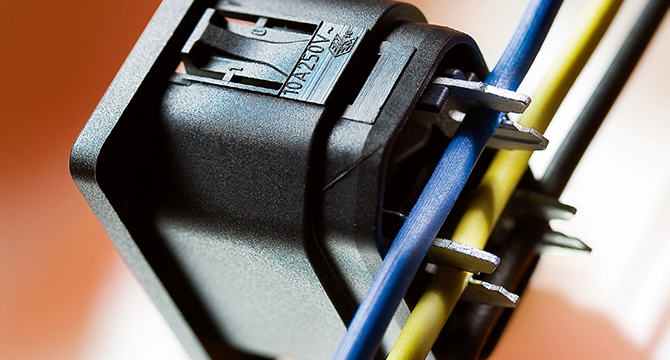
Posted to News on 26th May 2022, 11:30
Power connection technologies compared

Current obviously only flows when the circuit is closed. But the way to get there leaves many options. For example, how do you connect appliance sockets in a power distribution unit in the most efficient way? The experts at Schurter provide an overview of possible connection technologies for this application.
A power distribution unit has the purpose of supplying power to a large number of devices. It is subject to moderate mechanical shocks due to the plugging in and unplugging of device connection cables. In most cases, it also performs its duties in a thermally stable, ventilated room. So much for the general conditions. The connectors of the appliance couplers refer to the contacts on the inside of the connector. Let’s take a closer look at the advantages and disadvantages of the primary connection variants.
Manual soldering connection: Soldering is the joining of metal parts by a metal alloy (solder) under the impact of heat. The melting temperature of the solder is below the other metals to be joined. At the right temperature, the hot solder flows between the two metal parts.
Under appropriate conditions, a strong, tight, corrosion-resistant, current- and heat-conducting joint is formed between the solder and the metals.
In general, a distinction is made between soft and hard soldering. Soft solders have a melting point below 450 °C. Brazing solders have a melting point between 450 °C and 1100 °C. In electronics, soft soldering is standard.
Advantages: If the soldering is done by a professional and all contact points are free of oils, oxidation or other contaminants, a very good connection is made.
Disadvantages: Manual soldering requires a comparatively high effort. The cable or stranded wire must be stripped, and the work requires attention to detail.
Printed circuit board connection: Printed circuit board connection consists of a coated metal contact for soldering to a contact point of a conductor track on a printed circuit board. Basically, a distinction is made between through-hole technology (THT) and surface mounting technology (SMT). In the case of a power distribution unit, THT is the standard case.
Advantages: No cables are involved. Stripping is not necessary. If the soldering is also carried out by a professional and all contact points are clean, a very good connection is created.
Disadvantages: A mechanical load on the socket always leads to a load on the PCB as well, since these are rigidly connected. The soldering itself is again almost always done manually, which requires time and care.
Insulation displacement contact: An IDC is an electrical connector designed to be connected to the conductor of an insulated cable by a mechanical connection process. In this process, a blade sharpened on the contact surfaces to the cable is pressed through the cable insulation. When professionally handled, this connector blade welds to the conductor and makes a reliable, gas-tight connection.
Advantages: It is an enormously efficient process that does not require stripping or soldering. The connection withstands mechanical stresses well. Oxidation is also hardly an issue if done properly. It is a very cost-effective process, and connections can’t be done any faster.
Disadvantages: Cable diameters must match the insulation displacement connectors and may be rather stiff and straight. Thin strands are therefore less suitable. Pressing in the cables by means of special tools or the cover must be done with care and precision.
Quick connect: Quick Connect connectors correspond to metal terminals with standardised dimensions. Another common term for this is also Faston connectors, typically with dimensions of 4.8 x 0.8 mm or 6.3 x 0.8 mm. Accordingly, the connecting leads must be assembled with flat receptacles of the same dimensions.
Advantages: Very fast and easy-to-use connection technology.
Disadvantages: Since the metal tongues (pins) have standardised dimensions, the cable ends must be assembled with the matching counterpart, the flat receptacles, of the same dimensions. This makes the whole process time-consuming. The connection itself is purely mechanical. Oxidation can be an issue, as can mechanical shock.
Screw terminals: This is also a classic. In screw terminals, mechanical fastening of the stripped wire or stranded wire takes place by means of a grub screw.
Advantages: No soldering is necessary, only stripping. Mechanically it is an ultra-stable solution.
Disadvantages: The design of the connection with a solid grub screw is clearly more complex than a pure pin. The cable ends or strands are exposed to air, which leads to oxidation and correspondingly increased contact resistances.
Tailor-made strands: This is the ultimate solution. The power supply can also be provided without additional cabling elements. For this purpose, the device plugs are supplied directly with the connection strands. Pre-assembled stranded wires with connectors are even possible here, so that the power supply component can be mounted in the target device without any further work steps.
Advantages: Perfectly adaptable to the customer’s needs. Potting compound possible against potentially damaging mechanical influences.
Disadvantages: At first sight more expensive, since all the work to be accomplished has already been done.
In summary, then, for smaller quantities, manual soldering still has its justification. If done professionally, you get a very good connection, electrically as well as mechanically.
For larger quantities – and when it really has to go fast – the IDC connection can hardly be surpassed. Here too, however, care is required when pressing in the non-stripped cables.
However, the customised version is undoubtedly the ultimate solution. For high-end applications (such as medical technology) it is the ideal way to go. Schurter has been offering this service for several years and plans to expand it massively.
Want the latest machine building news straight to your inbox? Become a MachineBuilding member for free today >>
Unit 3, Mildshires Business Park
Smeaton Close
HP19 8HL
UNITED KINGDOM
+44 (0) 1296 319 000

















